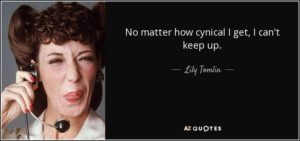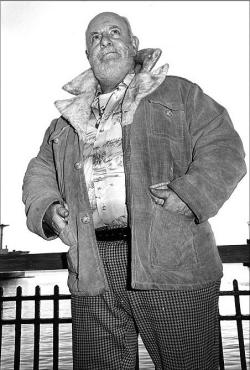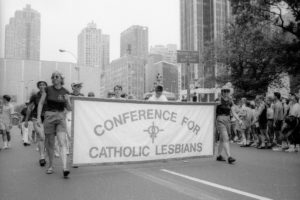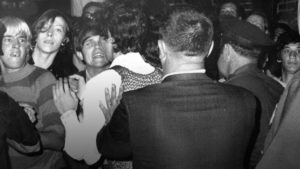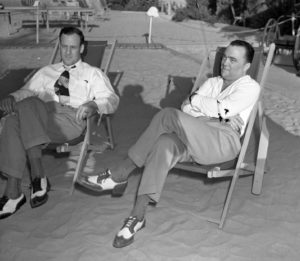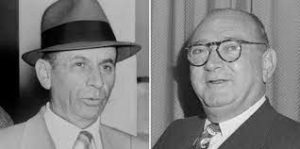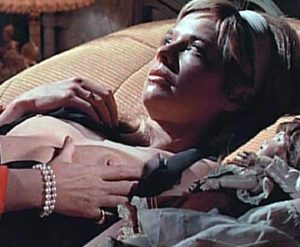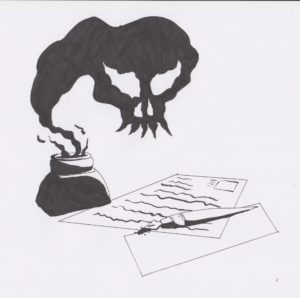Posted in category "Humor"
Lesbian = Nonbinary?
While scrolling through Instagram on Gay Pride Day, I came across a photo of an attractive young woman holding a cardboard hand-lettered sign that read “I WAS a nonbinary CHILD.” She was smiling and obviously having a good time proclaiming her identity during the 2023 NYC Dyke March. What was odd, I thought, is that the photo was promoted on the Instagram account of Lesbian Herstory Archives, a respected and renowned organization known for preserving the stories and artifacts of women who identified as lesbian. Puzzled, I commented under the photo: Nonbinary = lesbian?
My question prompted a flurry of comments on lesbian identity and sexual attraction. I have abbreviated each person’s Instagram handle to protect their privacy –
CIN (ME) – Nonbinary = lesbian?
DJBZ @CIN– why is a Catholic account questioning a lesbian account?
CIN@DJBZ – I’m a lesbian. Out since 1980.
DJBZ@CIN– understood – just feeling sensitive to seeing religious accounts commenting on pride posts this year. And yes some lesbians are non-binary!
STT@DJBZ – sorry, but to be a lesbian is to choose. No nonbinary lesbians can exist by definition. A woman who is romantically and sexually attracted to another woman is a lesbian. If you aren’t a woman then no, nope, you cannot be a lesbian. And if the Lesbian Archives cant handle that it should call itself something else. Because lesbians who actually helped to create our herstory will not donate herstorical item’s because why? It wouldn’t make any sense
DJBZ – trans and non-binary lesbians exist and are very hot and cool. Get over it : )
MT@DJBZ – straight men aren’t lesbians and never will be. Non binary is just “not like the other girls”.
MT@DJBZ – lesbian = homosexual woman
STT@DJBZ: nope you are just confused, and have way too much time on your hands
DJBZ – your opinions are ahistorical. Don’t follow a herstory page if you don’t like or understand herstory!
DJBZ@MT– you are wrong. Hope that helps!
CBF@CIN – Yes. We have much work to do in 2023. Paraphrasing Karl Marx (a dude) The point isn’t a naval gazes and police gender expression and identity at a dyke march – the point celebrate Dykes in a rainbow of expressions self-definitions and political power.
CIN@CBF – With all respect, that is your opinion. We live in a free country and we are all free to do and say as we think. I am clear – my sexual and emotional attraction is to women born female and who identify as female. Period.
GBG – hi queer as hell woman here. Maybe you should stop telling other people what their definitions are or should be. We are not being erased. The definition is changing as we grow. Happy Pride! 
CBF – And that’s wonderful. We have lots of precedent to look at within the feminist tradition and within the lesbian tradition What happens when people start challenging others authentic relationship to being in our space. It is an approach that leads to division it is an approach that leads to bad politics. It is an approach that leads to alienation and a lack of constructive engagement. It is an inward cop-like attitude towards members of our community instead of linking arms with the broadest possible grouping in the LGBTQ spectrum and fighting against discrimination and injustice. Your approach and it’s legacy have been toxic for our community. And frankly it has no place in the modern LGBTQ community. Nothing but love for you but these politics and viewpoints are antithetical to building a movement that can successfully defeat the bigots who are organizing to harm us
STT@GBG – maybe you should pay attention. Why bother using any words at all? Words are precisely for ‘definition’ to help people navigate. When lazy people such as you decide nothing matters, then leave our defining term alone, it HAS meaning and you are being a mouthpiece for the patriarchy by saying anyone can be anything AND use a term that means something. Go get an education
DJBZ – dear terfs – misinformation is an illness. Get well soon!!!!
I checked the Lesbian Herstory Archives Instagram account about an hour later to find the moderator had erased the entire exchange, including my initial comment – Nonbinary = lesbian? Only one comment was kept: the scold by DJBZ: “dear terfs – misinformation is an illness. Get well soon!!!!”
So, I decided to reprint the exchange for posterity. DJBZ, CBF, CBG and others like them don’t have a modern sensibility—they are turning the clock back to the 1950s lesbian pulp fiction. Those paperbacks were usually written by men pretending to be lesbians. The same thing is happening today.
The Mob Behind Dog Day Afternoon
“I’m a Catholic and I don’t want to hurt anybody. Understand!” yelled Sonny Wortzik, the bank robber played by Al Pacino in the memorable 1975 movie, Dog Day Afternoon. Pacino’s character was based on John Mojtowicz, 27, who along with 18-year-old Salvatore Naturile, and Robert Westenberg, attempted to rob a Chase Manhattan branch in Gravesend, Brooklyn on August 22, 1972. Westenberg fled when he saw a police car. All three men were gay. The night before the robbery they all had sex together at the Golden Nugget Motel.
In the movie, the main reason for the heist was to get money to pay for a male-to-female sex change operation for John Wojtowicz’s wife. That may have been part of Wojtowicz’s stated reason, but was it the whole truth? According to Liz Eden (born Ernest Aron), Wojtowicz’s transgender wife, Wojtowicz owed the Gambino family money. Some of that money went to pay for their December 1971 wedding, where they were married by a Roman Catholic priest. Liz Eden wore a wedding gown; John Wojtowicz his Army uniform and medals from the Vietnam war.
According to the FBI, Wojtowicz met Naturile a month prior to the robbery at a gay bar called Danny’s, located on Seventh Avenue South in the Village. Naturile agreed to participate to get money to rescue his two sisters from foster care. The guns used in the robbery supposedly came from Mike Umbers, 37, a Gambino family associate who ran a club, bar and bookstore in the West Village. Umbers fronted several gay bars, callboy rings and pornography operations for the Genovese and Gambino organized crime families. Wojtowicz was friendly with Umbers, much to the chagrin of his fellow Gay Activist Alliance (GAA) members. Wojtowicz was known as “Littlejohn Basso” (Basso was his mother’s maiden name) at GAA.
On August 26, 1972, this article about Wojtowicz’s Brooklyn heist appeared in the New York Times:
“An acquaintance of John Wojtowicz—who has been charged with robbing a Chase Manhattan branch in Brooklyn last Tuesday and holding nine persons hostage—reportedly told the Federal Bureau of Investigation yesterday that an underworld figure supplied the guns used by Wojtowicz and two accomplices in the holdup.” “The acquaintance, Gary Badger, was questioned by F.B.I. agents yesterday afternoon, but the bureau would not comment. A friend of Mr. Badger, however, said that he told the agents that five men, including Wojtowicz, began planning the robbery last April, but that two of the men later bowed out. Wojtowicz was pressed to carry out the robbery by the underworld figure, who owns Greenwich Village bars and is involved in pornography, Mr. Badger reportedly told the agents. Mr. Wojtowicz owed the gangster money, he said.” Arthur Bell, a respected Village Voice columnist and investigative reporter, interviewed Badger, who showed up at a GAA meeting to make a plea for money to help bury his friend, Sal Naturile.
Arthur Bell knew Wojtowicz through GAA meetings and dances. He interviewed Wojtowicz and published an article about the robbery in the August 31, 1972 edition of the Village Voice, “Littlejohn and The Mob, Saga of a Heist.” Wojtowicz described how he met a middle-aged Chase Manhattan bank executive at Danny’s. The executive told him how he could rob the branch of $150,000 to $200,000. The money in the bank’s safe was picked up early; so instead of the big payday only $29,000 was on hand.
Bell also knew Mike Umbers, and interviewed him in 1971, a year before the robbery. The article, “Mike Umbers: Christopher’s Emperor,” described his start in the sex business; first as a pimp for high-class call girls and brothels, and then catering to gay men. Umbers had his run-ins with police and other crime families. According to the article, “Corruption, Before and After Stonewall,” Mike Umber’s Christopher’s End club was trashed by police. It was possible that police destroyed the interior with hammers and axes because Umbers wasn’t paying them off; or, the attack was ordered by Al Moss, also known as Abe Moss, who ran some gay bars for the Gallo crime family in the West Village.
I was interested to read that Al Moss had a nephew named “Red” who paid the police $2,000 a month to protect The Barn, an after-hours club on Hudson Street. “Red” may be a reference to Red Mahoney, a long-time associate of Ed Murphy, who had his own checkered past as a gay blackmailer and gay activist. Mahoney worked with Murphy when he was alive and took over running the Christopher Street Festival after Ed died in 1989. Mahoney ran the Festival until 1992, when he became ill and stepped down. Mahony was a short, grumpy guy with dark red hair. He didn’t have Ed Murphy’s gregarious nature or command the same respect.
The vast web of connections between the mob (Genovese, Gambino, Gallo crime families), their associates (Murphy, Mahoney, NYPD), front men (Umbers), expendables (Wojtowicz, gay hustlers) and gay clubs and bars before and after Stonewall continues to amaze me. The connections were essential to their multi-million dollar businesses of bars, clubs, pornography, prostitution and blackmail.
Was the middle-aged Chase Manhattan executive who tipped off Umbers and Wojtowicz being blackmailed?
The Perils of Social Media
Monsignor Jeffrey Burrill, the former general secretary of the U.S. Conference of Catholic Bishops, used Grindr, a gay male dating and sex hookup app, at his office, home and while on trips for the USCCB. In his position at the USCCB, Burrill played a key role in coordinating national and diocesan responses to sex abuse and coercion scandals. He and several senior USCCB officials met with Pope Francis Oct. 8, 2018 to discuss how the conference was responding to ecclesiastical scandals related to sexual misconduct, duplicity, and clerical cover-ups.
On June 20, 2018, the day the McCarrick sex scandal became public, Burrill’s cell phone emitted hookup app signals at the USCCB staff residence, and from a street in a residential Washington neighborhood! He traveled to Las Vegas a day or two later. On June 22, the mobile device associated with Burrill emitted signals from Entourage, which bills itself as Las Vegas’ “gay bathhouse.”
Burrill resigned on July 20, 2021, after The Pillar, a Catholic investigative journalism site, revealed the extent of his almost daily Grindr usage.
“If someone who has made the promise of celibacy or a vow of chastity has a dating app on his or her phone, that is asking for trouble,” said Cardinal Joseph W. Tobin of Newark, NJ at a Zoom panel organized by Georgetown University.
The Pillar tried to reveal a few more Grindr exposés of priests in the Newark archdiocese and in the Vatican but they were squelched.
Less than a month later, another clerical higher up made the news: “Pope replaces Bishop After Video of Him Masturbating on Zoom Call with Another Man Leaks on Social Media.” Tome Ferreira de Silva, the bishop of the Diocese of Sao Jose do Rio Preto in Brazil, had previously been accused of having an affair with a young man working as his driver and ignoring credible allegations of local priests having sex with teenagers. The video was released to a local TV station. A still of the video shows the bishop playing with himself. Several previous Vatican investigations of the bishop came to nothing.
Monsignor Burrill slunk off without saying anything. Bishop Ferreira de Silva publicly groused about his exposure.
When I read these stories and exposés a favorite saying from Lily Tomlin (another lesbian!) springs to mind:
“No matter how cynical I get I can’t keep up!”
Ed Murphy: Gay Blackmailer and Activist – Chapter 7 – The Improbable Activist
After the Stonewall raid, Ed Murphy went to work at Tele-Star, another gay bar. The Tele-Star was raided soon after by police. Murphy told friends that he refused to let police into the bar, so they had beaten him up very badly. He was covered in cuts and welts, had bandages all over his face, his arm was fractured, and he was barely able to walk. The beating may have been at the instigation of Deputy Inspector Seymour Pine, who must have been furious about not netting him at Stonewall. Some officers may still have been angry that Murphy impersonated a police officer during the “Chickens and the Bulls” extortion schemes, and it was payback time. Murphy was also raped by a black inmate during his jail stay. Murphy said the police heard he “liked niggers” and that he hung out with and protected black teenagers and transvestites. After Murphy was released from jail, he stopped informing for the NYPD.
In 1978, Ed Murphy “came out” as a gay man and stopped informing on the Mob to the FBI. He was 52. Murphy claimed that he wanted to quit both his careers as a criminal freelancer and as an informer, and work for gay liberation. He wanted to become a “good guy.” Ed continued working at gay bars, which were mostly mob run, so his association with members of the Genovese and Gambino families continued until his death in 1989. I don’t see how the Mafia would let an informer walk around and live; Ed would have ended up in a swamp, empty field, or vacant lot. Having Ed inform to the FBI was useful—he could have been fed information about certain people and his informing allowed the Mafia to keep tabs on FBI activity and plans. Ed saying that he no longer worked for the FBI may have been true or a ruse. Murphy did testify in 1979 that he had been an undercover agent specializing in gay bars and corruption for the New York State Select Committee on Crime.
In a May 8, 1978, Village Voice article by Arthur Bell, “Skull Murphy – The Gay Double Agent,” Murphy disclosed that he decided to come clean because certain mobsters became aware he was an informer. “Everything I know is on file at law enforcement agencies for certain people doing investigations,” he told Bell. Look, I’m getting old. I’m getting out of this business, baby. I’m doing it for one reason. I want to see their asses kicked.”
I find it impossible to believe that Ed Murphy ratted on the mob for years and lived to walk away after testifying. He was low level and sullied enough that a gunman could put a bullet in his head and get away with only a pretense of an investigation. Who would mourn? Not the influential gay men and officials that he served and compromised. Not the NYPD. Instead, Ed continued to live and work in New York at mob-affiliated gay bars and clubs. He solicited cash donations from businesses, many of them mob-owned, to help fund the Christopher Street Festival and annual gay pride day parade. More likely, much of the information that Murphy provided had to do with corruption and sexual antics by politicians, government officials, men in law enforcement, and others that would be embarrassing to be publicly aired. A friend reacted to Murphy’s pronouncements: “Even the criminal element has a code of ethics. If the Skull’s planning a trip to heaven, he won’t get there by hurting people.”
In 1972, Murphy founded the Christopher Street Festival Committee. It was started to help the local merchants profit from Gay Pride Day and, to give people who felt uncomfortable marching a place to meet and mingle with other gay people. When I was marching in the 1980s and early 1990s, there were thousands more people at the festival than at the parade. The parade included primarily middle class and affluent white people. There were a lot of banners of community service or activist groups, including religious groups and some church and synagogue groups. The original march in 1970 started in the Village and ended up in Central Park.
By 1974, Murphy had persuaded march organizers to start the parade uptown and finish at Christopher Street. His main motive was probably money, since the bars, clubs, booth merchants, and area businesses would rake in bags of cash from marchers and revelers. But while making money was the biggest driver, I also feel that Ed wanted to include the thousands of people who didn’t march out of fear of family rejection, job loss, or just fear. Many of them were black, Latino, and blue-collar whites. Murphy almost single-handedly ran and controlled the festival. Most participants were happy with the crowd and the freedom to “be,” if only for an afternoon or night. “People often wondered where they money went,” said Candida Scott Piel, a long-time AIDS and gay rights activist who helped to organize the Pride parade and rally in the ‘80s. “But if your group ever needed help, or you were just someone in need, Ed was always there to lend a hand or find someone who could.”
Every year Murphy would come by the Conference for Catholic Lesbians booth on Christopher Street to say hello, see how we were doing, and make sure that no one from the commercial vendor booths was bothering us. Eventually he would end up at one of the nearby bars, like Two Potato, holding court with a group of young guys. Prior to the Festival, Ed took part in the Pride parade. He would ride with a group of young men in a Cadillac convertible. A picture from the 1984 parade shows him all dressed up in a blazer wearing a blue sash with the words, “The Original Stonewaller.” His hands are raised as if in a benediction to the crowd.
Ed Murphy’s life after Stonewall had taken a surprising turn after his previous incarnations as a juvenile delinquent, WWII soldier, armed robber, gay bar bouncer, pro wrestler, pimp, house detective, fairy-shaker, and informant: he became a community activist. During the 1970s and ‘80s, Ed Murphy was known for charity work with homeless street youths, drag queens, prostitutes, people suffering with AIDS and the mentally handicapped. He was named New York State’s volunteer of the year in 1977 for his work with people with developmental disabilities.
Ed Murphy would round up his friends and treat people in residential facilities to parties for Thanksgiving, Christmas, Easter, and summer picnics. He would dress up as Santa Claus for Christmas, and in his all-purpose tramp-clown outfit for the other occasions. “He’s a marvelous man,” said the coordinator of volunteer services for one of the homes. “Whenever we need something in a pinch, Ed Murphy is there. It doesn’t matter if it’s shoelaces or an excursion.” Murphy did whatever needed to be done to make Christmas special. “One year we wanted to have a house for Santa Claus to sit in, but we didn’t have no money,” he recalled. “So a couple of the guys go down to this yard on 10th Avenue and rob some lumber. After the party, they put it back, but the owner comes into the bar and complains. I asked him what he’s yelling about, its only got a couple of nail holes in it. The next year, he donates the lumber for free.”
From his job as a doorman/bouncer, Ed collected a group of fellow bar workers, patrons and ex-cons who help him with the parties. “We’re here with Eddie,” said a man who pushed a cart full of presents for the residents told a reporter. “The guy’s a nice guy, and, like, he loves people. I been in a few institutions myself, so I know what that means.” Murphy had an informal group of 50 bars, most of them gay bars, to help provide food, drinks, and gifts for the parties. “We don’t accept money,” Murphy said. “We’ll ask one bar for hamburgers, another for soda, and so forth.” He got bakeries to donate to AIDS hospices and old age homes. He even got Detective Jim McDonnell from his “Chickens and Bulls” days to do some volunteer work when he retired. Murphy surprised McDonnell with a plaque at an awards dinner.
After Stonewall, Ed Murphy appears to have made a complete transition from a thug who threatened gay men for money; to a burly, bewhiskered Santa Claus who distributed gifts and treats to bring joy to people who would have had neither. What happened to Ed Murphy? Why did people never mention his role in the “Chickens and the Bulls” or even his alleged blackmail role for the mob at Stonewall? It was the ultimate irony to see the man the cops were after during the Stonewall raid for financial crimes at the head of the Gay Pride parade proudly wearing the sash proclaiming, “The Original Stonewaller.”
Ed Murphy: Gay Blackmailer and Activist – Chapter 6: The Stonewall Raid
Once the New York Police Department learned that the stolen bearer bonds were tied to the Stonewall Inn, they set out to shut down the club and arrest Ed Murphy. In the early hours of June 28, 1969, a few hours after Judy Garland’s funeral, the police raided the club. The force was led by Deputy Inspector Seymour Pine, and carried out without the knowledge of the local precinct which was suspected of being on the take. Even though they were after Murphy, the police officers were brutal to the patrons.
They started the operation by sending in two policewomen “posing” as lesbians and two plainclothesmen. The undercover women were from Chinatown’s Fifth Precinct. They were chosen because of their sizes (one large, one petite) to be a butch-femme couple. Pine became worried when the two policewomen didn’t return. “They didn’t come out of the bar,” Pine said. “Time passed. It seemed unnatural. We didn’t realize they were having a good time. It got to the point where we thought they were in trouble or had forgotten what they were supposed to do.” Ed Murphy recalled, “the two cops were drunk…Even the policewoman was half-crocked. She was a Polynesian broad. And she’s been coming there as a dyke.”
In an interview with the SAGE (Senior Action in a Gay Environment) History Project, Ed Murphy recounted his own memories of the Stonewall Raid. An excerpt was published in the June 1989 SAGE newsletter. “I was one of the two men employed as bouncers at Stonewall on the night of the celebrated raid,” Murphy said. “I was told that the monthly payoff to the cops from Stonewall was $1200 plus frequent cases of booze. The Inspector got his $1200 payoff the very night of the raid, using his chauffer as bagman as usual. Every gay bar paid.”
“Stonewall was an after-hours premises, not a bar. It had two big oak doors rather like doors to a monastery. Inside that were steel doors. Inside the premises there was a Wishing Well in the middle of the dance floor and upstairs the “mob” retained a room. A Polynesian policewoman was already inside when the doors were slapped shut against the raid.”
“Maggie (Jiggs) is said to have thrown the first beer can at the police. Marcia picked up dog shit and threw it in a cop’s face. Maggie got out with the money…She put the money under her apron, told the cops, “I just sell cigarettes here” and got away with the money so the cops didn’t get any. Meanwhile, Frankie, the other bouncer, and I were handcuffed by the cops. In the melee we jumped into a cab. Turned out to be a gay cabbie who sped us off to Keller’s Bar. There the S&M crowd had keys that fit the handcuffs.”
The SAGE newsletter editor noted that Ed Murphy had recently died. He described him as: “a long-standing, compassionate and vociferous member of the gay and lesbian community. His leadership and strength were constant and are sorely missed.”
If the main objective of the Stonewall raid was to arrest Ed Murphy and haul in a load of incriminating evidence, it was a total failure. There was no mention of whether the “upstairs room” was searched. Ed slipped away even though he was handcuffed. It makes you wonder if the police were totally incompetent or if Murphy was tipped off to the raid by a source or even one of the police who infiltrated Stonewall before the raid. Fury at both the police and the Mafia fueled the crowds. One of the goals shared by the Gay Activists Alliance and the Gay Liberation Front, two groups that came out of the Stonewall protests, was to get organized crime out of gay bars. That didn’t happen immediately. Bars, clubs, pornography, and other gay-related businesses were far too lucrative for organized crime to give up easily.
Ed Murphy: Gay Blackmailer and Activist – Chapter 4 – Secret Lives: J. Edgar Hoover and Roy Cohn
Ed Murphy told me: “J. Edgar Hoover is one of my sisters.”
In 1983, I was shocked to hear Ed insinuate that the late FBI director was gay and liked to dress in women’s clothes. Even among very gossipy gay men, I never heard a breath of rumor that the late FBI director liked guys and was also a transvestite. Similarly, in the 1980s at Dignity/NY, I learned that the ruthless society lawyer, Roy Cohn, had contracted AIDS, not cancer of the liver as he claimed. Ed may have known about Hoover from firsthand stories he heard, and likely had pictures to prove it. I’m not clear if Ed Murphy’s claims are from the time of the “Chickens and the Bulls” blackmail period, or, whether the Mafia had compromising photos of Hoover and his associate director and companion, Clyde Tollson, from years before.
In his explosive 1993 book, “Official and Confidential: The Secret Life of J. Edgar Hoover,” author Anthony Summers claimed Hoover denied the existence of the Mafia and never pursued them because the Mafia had blackmail material on him. One of the photos was said to show Hoover blowing Clyde Tollson. The knowledge of Hoover’s homosexual activities may have kept gangsters like Meyer Lansky and Frank Costello safe from FBI scrutiny.
Author David Carter wrote in his 2004 book, “Stonewall: The Riots That Sparked the Gay Revolution,” that when FBI agents joined the “Chickens and the Bulls” case, they found a photograph of J. Edgar Hoover “posing amiably” with one of the ringleaders and discovered information that Clyde Tollson was being blackmailed by the extortion ring. Both the photograph and documents disappeared after the FBI joined the investigation. David Carter thought Ed Murphy was the man posing with Hoover. Journalist and author Burton Hersh said that it was Sherman Kaminsky. It may be that Ed Murphy’s decades of work in Mafia-run gay bars, and his involvement in male prostitution and blackmail gave him access to knowledge and photos, which not only kept him safe from the Feds, but out of jail in the “Chickens and the Bulls” case.
Elwood Hammock, one of the chief extorters in the “Chickens and the Bulls” case also said that J. Edgar Hoover was homosexual as detailed in a memo dated May 19, 1966, from Special Agent in Charge (SAC) in Charlotte, N.C. to Director, FBI. The memo describes a taped telephone interview with an unnamed woman the evening of May 18, 1966. It was conducted by FBI agent Charles S. Miller of Durham, N.C.
“(BLANK) stated that on or about 4-10-66 (BLANK) ELWOOD HAMMOCK (BLANK) New York City. She recalled that ELWOOD was intoxicated at the time, and he was discussing various personalities in whom he and his confederates were interested. During the course of this conversation, he stated to her that J. EDGAR HOOVER was a homosexual. He stated also that he, ELWOOD HAMMOCK, and (BLANK) who she later learned was (BLANK) allegedly had telescopic movies or photos of a blond, blue-eyed young man who resided in either Georgetown or Bethesda, Maryland. It was not clear to (BLANK), but she gathered that this young man was guarded by two Doberman pinscher dogs, and she gathered by inference that this young man was an alleged friend of MR. HOOVER. She stated she was shocked when ELWOOD made such a fantastic allegation, and she informed him that it was utterly impossible and untrue. She stated that (BLANK) was an inveterate liar, and she placed no substance in his statement. She stated she admired the Director greatly, recognized what he had done for the country, and as she thought about the matter more, she decided to repeat ELWOOD’S conversation to a Detective (BLANK) of the New York District Attorney’s staff with whom she had been working.”
The person who had the most damaging information about J. Edgar Hoover was Susan Kaufman Rosenstiel, the 4th wife of liquor magnate Lewis S. Rosenstiel, chairman of Schenley Industries, Inc. Rosenstiel, a bisexual, was a former bootlegger who was a close associate of mobsters Meyer Lansky and Frank Costello. He was good friends with power broker attorney, Roy Cohn, and J. Edgar Hoover. He endowed the J. Edgar Hoover Foundation with $1 million in 1965. Lewis Rosenstiel’s lifelong involvement with mobsters came to light only in 1970, when the New York State Legislative Committee on Crime determined that he was part of a consortium to smuggle liquor during Prohibition.
Lewis and Susan Rosenstiel had an ugly, contentious divorce before Lewis Rosenstiel moved on to Wife #5. Rosenstiel spent almost half a million dollars trying to concoct evidence to use against his wife in divorce proceedings. He may have turned to his friend, J. Edgar Hoover, for help. At least, this is what Susan Kaufman thought, believing that the FBI director helped stack the cards against her in divorce court. In retaliation, she told anyone who would listen that Hoover was a cross-dresser and homosexual.
During their divorce, Rosenstiel’s 4th wife, Susan Kaufman, alleged that Rosenstiel hosted orgies at the Plaza hotel where he supplied “boy prostitutes” for certain guests. Kaufman would later make the same claims under oath for the New York State Joint Legislative Committee on Crime in the early 1970s. Most of Kaufman’s testimony to the Committee was behind closed doors and remains sealed. Her claims are shocking, but both the Crime Committee Chairman, John Hughes, and his Chief Counsel, Edward McLaughlin, found them credible. McLaughlin remembered her as an excellent witness: “I thought she was absolutely truthful. The woman’s power of recall was phenomenal. Everything she said was checked and double-checked, and everything that was checkable turned out to be true.”
Larry Summer’s book, Official and Confidential: The Secret Life of J. Edgar Hoover,” describes one night in 1958 where Susa n Rosenstiel witnessed a sex scene with her husband, Roy Cohn, J. Edgar Hoover and two teenage boys in a suite at the Plaza Hotel in New York. Hoover was in drag, “wearing a fluffy black dress…lace stockings and high heels, and a black curly wig. He had makeup on, and false eyelashes. Roy introduced him as “Mary” …It was obvious he wasn’t a woman; you could see where he shaved.” They had some drinks, and the teenage prostitutes arrived. They went into the bedroom and “Mary” undressed, taking off his dress and pants and leaving on a garter belt. He lay on the bed, “and the boys work on him with their hands. One of them wore rubber gloves…Then Rosenstiel got into the act with the boys. I thought, “You disgusting old man.” Hoover and Cohn were watching, enjoying it.”
If what she described happened, it would be easy to imagine that Meyer Lansky and others in organized crime had blackmail photos of Hoover in a dress or getting serviced. Susan Rosenstiel quoted her husband as saying, “because of Lansky and those people, we can always get Hoover to help us.” Hoover was a blackmailer himself. “He was the biggest fuckin’ extortionist in the country,”
Ed Murphy told Arthur Bell in a 1978 interview. “He had presidents by the balls. He had a record on everybody and his brother.”Not everybody believed Susan Kaufman’s stories. Robert M. Morgenthau, the U.S. Attorney in New York, found her claims baseless. So did famous attorney William Hundley, at that time working in the U.S. Justice Department. “Susie Rosenstiel had a total axe to grind,” Hundley said. “Somebody who worked for me talked to her. It was made up out of whole cloth. She hated Hoover for some alleged wrong he had done. Plus the story was beyond belief.”
The story does sound fantastical. How could the head of the FBI–and a notorious blackmailer himself–get himself into a position where he was held hostage? Perhaps it was a trade-off. Hoover had his secrets protected and access to male prostitutes. In return, organized crime didn’t need to worry about the FBI nosing too deeply into their operations.
Coming Tomorrow: Chapter 5: Stonewall Shakedowns
A Look Back at Coral Browne and The Killing of Sister George
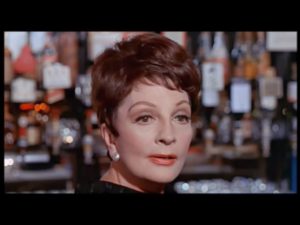 Coral Browne (July 23, 1913-May 29, 1991) was an accomplished stage and screen actress. She was also actor Vincent Price’s third wife. She was a woman who enjoyed a varied and robust sexual life. Browne portrayed no-nonsense BBC-executive, Mercy Croft, in The Killing of Sister George, a film depicting a lesbian love-triangle. She is perfect as a smooth, predatory seductress—a role in which she had plenty of experience.
Coral Browne (July 23, 1913-May 29, 1991) was an accomplished stage and screen actress. She was also actor Vincent Price’s third wife. She was a woman who enjoyed a varied and robust sexual life. Browne portrayed no-nonsense BBC-executive, Mercy Croft, in The Killing of Sister George, a film depicting a lesbian love-triangle. She is perfect as a smooth, predatory seductress—a role in which she had plenty of experience.
Coral Browne converted to Catholicism shortly after World War II and remained a devout Catholic throughout her life. As a gift to her, Vincent Price converted to Catholicism. Her friend, Noel Davis, described the melding of her personality and faith: “I’m a Catholic of a sort, and I was always amused by her Catholicism because she was much more devout than fitted in with her obscenities. She never missed Mass on Sunday.” Existing the Brompton Oratory one Sunday morning, salty-tongued Browne was accosted by a theater friend with the latest gossip. She stopped him midsentence, exclaiming: “I don’t want to hear such filth, not with me standing here in a state of fucking grace.”
Browne did not get along with Vincent Price’s daughter, Victoria Price, but they both shared an interest in women. “Coral lent a sympathetic ear to my romantic troubles. Both were eager to meet anyone I brought home, though my stepmother rarely missed an opportunity to flirt outrageously with my girlfriends or to comment on their looks and style. One woman, she told me with a very knowing smile, “does it very well.” I took that as some kind of compliment.” Coral also told Victoria Price about a five-year relationship she had with a woman. Its dissolution was, according to Browne, the most heart-breaking moment of her life. 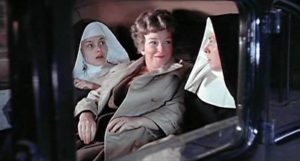
In The Killing of Sister George (1968), BBC executive Mercy Croft (Coral Browne) is sent to chastise Sister George/June Buckridge (Beryl Reid) for a drunken incident involving two nuns. Buckridge is a middle-aged soap opera actress, and Alice “Childie” McNaught (Susannah York), her lover, has a minor fashion industry job, writes poetry and collects dolls. George/June is often verbally and physically abusive to Alice, and her treatment of her becomes worse as her character is scheduled to be eliminated on the popular show. The movie was given an “X” rating because of a two-minute masturbation scene between Coral Browne (Mercy Croft) and Susannah York (Alice “Childie” McNaught). The scene was panned as cold and unsexy—probably because they had most of their clothes on and didn’t writhe and moan continuously. But in 1968 it was revolutionary to see two mature women–McNaught was in her 30s and Croft was in her 50s–having sex to orgasm in a movie.
The movie was also history-making in that the director used a real lesbian bar for the lesbian club scene. Between June 9-16, 1968, The Killing of Sister George was shot at the Gateways, a lesbian club that operated in London between 1931 and 1985. Forty members were used as extras, one of whom lost her job when her employer recognized her in a publicity still. George and Alice go to an event at Gateways to which George jokingly invites Mrs. Croft. Mrs. Croft arrives to tell June in person that Sister George will die by being hit by a ten-ton lorry, eliminating her from the show. After June storms out, Mrs. Croft invites Alice to meet with her to further discuss her poetry. Alice has found a new lover/provider and June blew her chance with a woman she once desired and adored.
I wonder how Coral Browne reconciled the sexual and religious aspects of her life. She doesn’t strike me as a hypocrite and didn’t feel obligated to “leave” the Church. Browne died in 1991 without expressing a public opinion or statement; so we’ll never know her thoughts and feelings. The one aspect we do know is that she appeared to value monogamy while married. She had Vincent Price give up a male friend to whom he was strongly attached. That hurt Price deeply. It’s my one mark against Coral Browne.
How do you remain as lesbian and Catholic? My stance—perhaps Coral Browne’s—is to embrace the beautiful and positive in both and dismiss the negativity from secular skeptics and religious gatekeepers. The focus on what is most important – our relationship with God – can be difficult to achieve with all the worldly chatter and distractions; but over time we can sustain it through prayer, quiet time, meditation and the Eucharist.
Click here to see a trailer of The Killing of Sister George.
Click here to see a YouTube video of the Gateways club scene in the film.
The National Catholic Register Stumbles Over Archbishop Vigano’s Poison Pen
I’m glad I’m not Jeanette DeMelo, editor-in-chief of the National Catholic Register. Today will not be a good day in the office. Vatican correspondent Edward Pentin received a few demerits, too. No holy card prize for best writer this week.
Yesterday, May 7, 2020, the Register published “Appeal for the Church and the World.” Read the letter here. Drafted by Archbishop Carlo Vigano, the letter claimed that the coronavirus pandemic has been exaggerated to foster widespread social panic and undercut freedom, as a preparation for the establishment of a one-world government. It is a religious freedom screed along the lines of “Easter People” – a petition released a month ago by Dr. Janet Smith, ex-Sacred Heart Major Seminary professor.
Vigano’s letter was published by several EWTN-owned media companies, including the National Catholic Register and Catholic News Agency (CNA). Campaign Life Coalition, an ultra-conservative Canadian organization, also published the letter on their website, LifeSiteNews.
Listed right after Archbishop Vigano as a major signatory was Cardinal Robert Sarah, prefect of the Vatican’s Congregation for Divine Worship and the Sacraments. Cardinal Sarah denied signing the letter. “I share on a personal basis some of the questions or concerns raised with regard to restrictions on fundamental freedoms,” he tweeted on his Twitter account, “but I have not signed this petition.”
Bishop Joseph Strickland, the Bishop of Tyler, Texas, told Catholic News Agency in a May 7 email that he “did not sign off on this letter.”
DeMelo said that Archbishop Vigano had vouched for the authenticity of Cardinal Sarah’s signature. “The Register contacted Archbishop Vigano the principal author, and asked him specifically about the authenticity of the signature of Cardinal Sarah and he said: “I can confirm 100% that Cardinal Sarah signed it,” DeMelo told CNA.
Either Archbishop Vigano or Cardinal Sarah are lying. Which one?
It is safe to say the Register won’t be publishing any more letters from Archbishop Vigano and his minions anytime soon without independently verifying every statement and name.







